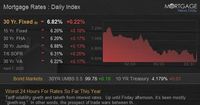Mortgage rates are experiencing significant fluctuations amid ongoing economic turmoil and uncertainties related to the Trump administration's trade policies. As global stock markets continue to face downward pressure, mortgage rates have recently shown signs of volatility, moving both up and down in response to market conditions.
As of April 7, 2025, the average 30-year fixed mortgage rate has reached 6.66%, reflecting a slight increase from the previous week. This rate is still considerably higher than the record low of 2.65% observed on January 7, 2021, and far from the peak of 8.89% recorded on December 16, 1994. The 15-year fixed mortgage rate also saw a rise, now averaging 5.94%, compared to its historical low of 2.1% in July 2021 and a high of 18.63% in September 1981.
On the morning of April 7, 2025, the 5/1 adjustable-rate mortgage (ARM) averaged 5.98%. These rates indicate a mixed picture for borrowers, as the market's reaction to recent economic reports and geopolitical events continues to shape lending conditions.
The yield on 10-year Treasury notes increased from 3.944% to 4.066% on April 7, which typically translates into higher mortgage rates. However, the stock market's decline can often lead to lower mortgage rates, as investors flock towards bonds for safety, pushing prices up and yields down. This complex relationship is further complicated by fluctuating oil prices, which dropped to $61.06 a barrel, and gold prices, which fell to $3,029 an ounce.
The CNN Business Fear & Greed index also saw a decline, dropping to 3 from 5 out of 100, indicating increased investor caution. As the economy grapples with the fallout from the ongoing trade war, the likelihood of a recession has increased. Goldman Sachs recently raised the probability of a U.S. recession to 45%, while JP Morgan Chase has adjusted its forecast to 60%.
In the coming days, significant economic reports are expected to impact mortgage rates further. On April 8, 2025, Federal Reserve Governor Adriana Kugler is scheduled to deliver a lecture at Harvard University on inflation dynamics. Additionally, the Fed will release its consumer credit report, with forecasts suggesting a decrease in consumer credit from $18.1 billion in January to $15.5 billion in February.
Looking back, mortgage rates had been on a downward trend last week, with the average for 30-year fixed-rate loans falling to 6.70% by April 4, 2025. This was a decrease from 6.82% on March 28, 2025. The 15-year fixed rate also dropped from 5.88% to 5.77% during the same period. Jumbo loans, which exceed the conforming loan limits set by Fannie Mae and Freddie Mac, saw a slight decrease in rates as well, falling to 6.71%.
Despite these recent declines, the market remains unpredictable. The 30-year fixed mortgage, after hitting a low of 6.60% on April 4, jumped to 6.82% on April 7, marking the largest single-day increase of the year. This volatility is attributed to the ongoing trade war and the uncertainty surrounding tariffs, which have led to fluctuations in both the stock and bond markets.
Real estate economists are now bracing for a turbulent spring buying season, as mortgage rates may fluctuate significantly in response to the evolving economic landscape. While rates could potentially decrease if the economy slows, the imposition of tariffs could also lead to higher prices and inflation, complicating the situation.
Chen Zhao, an economist with Redfin, expressed concerns that the Federal Reserve may opt against rate cuts despite the current economic challenges. With rising tariffs, there is a growing fear of stagflation—a scenario characterized by stagnant economic growth coupled with high inflation. The Fed's decisions in the coming months will be crucial in determining the trajectory of mortgage rates.
In summary, the current mortgage landscape is marked by uncertainty, with rates fluctuating in response to a myriad of economic factors. Borrowers should stay informed and consider their options carefully as they navigate this volatile market.








